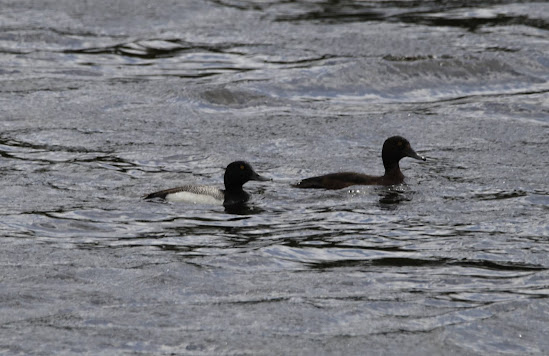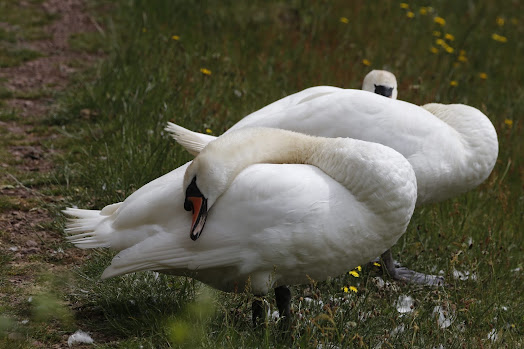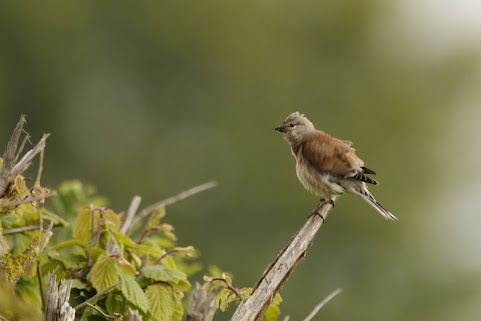On the first day of my holiday in northumberland, I decided to leave the county and headed over the border for a call on St Abb's in Scotland. A National Nature Reserve, owned by the National Trust for Scotland, the place holds dramatic cliffs which attracts large sea bird colonies. Something lacking from the birdlife of Suffolk are the sea bird cliffs that provide the coastline to this area of the country. Soft Suffolk lacks the majestic landscapes that provide a home to the sheer numbers of birds that nest here at St Abb's. These bird colonies are the reason why I came up to the Border region for a holiday.
You really get a feel for the place from the start. The footpath starts off easily enough, winding its way through gentle, civilised farmland, giving nothing away as to what was coming up. But then this farmscape drops away, and the cliffs open up before you into this stunning vista. Sheer, foreboding cliffs, sea bird colonies and a footpath rising high into the hills. The landscape was stunning, as good as any reason to visit really. The reserve takes a lot of heavy walking, but it takes you far above the cliffs to enjoy the bird spectacle taking place below.
Although there are a lot of birds nesting on St Abb's, its not as breathtaking, bird wise, as you would expect. In comparison to the Farnes, St Abb's is rather modest in its bird numbers. The sheer number of people that visit the reserve mean that there are no sea birds nesting near the top of the cliffs. A lot of people walking the reserve has disturbed birds from the cliff tops. The auks then, tended to nest half way down the cliffs, well away from the people, with SHAGS nesting even closer to the water. But this is a minor gripe really.
You could tell where the sea birds were nesting on the cliffs because the rock underneath would be painted white, from the guano of the bird's droppings. The smell and the sound of these bid colonies were really visceral, providing a feast for the senses, full on birdwatching.
There are no puffins at St Abb's, but the rest of the usual suspects were present. The most numerous bird was the GUILLEMOTS with lots present, with smaller numbers of RAZORBILLS, as well as FULMARS, KITTWAKES and SHAG. Offshore, but not nesting here were plenty of GANNETS, these large white birds fly hundreds of miles in search of food to feed their young at colonies further up and down the coast.
An overlooked bird, but one that provided an interesting record was that of the HOUSE MARTINS. Common birds, sure, but as inhabitants of the built, manmade environment. But strangely enough, here at St Abb's the sheer cliffs provide them with their natural nesting environment, which the human's buildings came to mimic. Here was an example of how the natural environment of a bird has been recreated unwittingly by us humans how we can be a force for good. Also present on the rocky shore were a few ROCK PIPTS, much darker than the more commoner MEADOW PIPIT, which were also present, with black legs and a distinct monosyllabic call.
The headland is rugged, giving a good physical workout, walking its undulating footpath, but it never ventures into anything too hard like scrambling. The path takes you over the cliffs before reaching the lighthouse, where the footpath loops inland. The grassland that are set back from the cliffs, which the path wanders through are carpeted in the pink flowers of THRIFT and the yellows of BIRD'S FOOT TREFOIL a beautiful palette of colours, something that has become so rare in our industrial agricultural landscape, but at one time were fairly common. A feast for the eyes and an earthly pleasure indeed, like all wildlife experiences.
As the path reaches the lighthouse at the end of the headland, the path loops inland, round Mire Loch. It was here where things took an unexpected turn. Mire Loch is a long and thin stretch of water, surrounded on both sides by the high ground of St Abb's. REED BUNTINGS sing from the emergent reeds and NORTHERN MARSH ORCHIDS flower on the marshy sides. A flock of TUFTIES were present and whilst counting through them I noticed a strange duck, the size of a tuftie, but with a grey back. Was it a LESSER SCAUP? I hoped, I dreamed it was.
The original email I sent to the Scottish Ornithological Club asked them if the strange duck I saw on Mire Loch was a LESSER SCAUP. Several emails, with a photo attached, were exchanged with several local bird watchers, and in the end it proved that it was. And believe me it was unexpected: a lesser scaup in June? It came from nowhere really. It was from the National Trust ranger who I got the final confirmation. He had seen it the same day, but at a later time. So I was the first to see it. This is the first time I've seen a bird of this species, so it was a lifer. Total bragging rights. Not bad for a strange visitor from Suffolk.
Because the bird was mated to a TUFTIE, it was a potential nesting bird, and therefore it was not going to be advertised, even if the youngsters would have been sterile hybrids. Imagine having nesting lesser scaup in Scotland, that would be ace. And despite the loch being walked past by thousands of people it seems no one would notice the strange looking duck from another hemisphere idling its life away there. I'm still surprised that I saw it at all. Maybe in my past I have walked past many rare birds just like it without noticing.
LESSER SCAUP originate from North America where they are fairly common. This bird got blown across the pond, and now can't go back. Forced to wander across the country, in the company of similar TUFTED DUCK, this bird is an alien in a strange world. And as for the TUFTIES, there were around twenty in total, with some coots and mallards also present, quite a good showing really.
What a surprise this reserve had for me, in the form of an unexpected lifer. A mid June sighting of a lesser scaup, mixed in with some good views of sea birds. It was also good walking country energetic but not too strenuous, walking this rugged landscape. This is the kind of reason why I go to the bother of going out to places like this, it can at times really pay off, and yes I well recommend a visit.



































